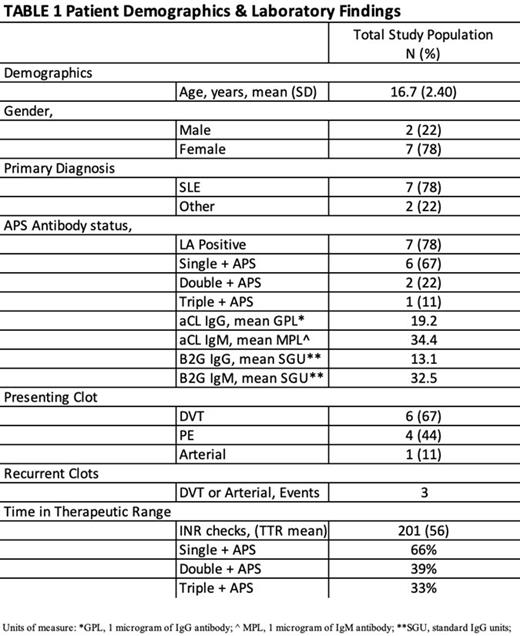Background:
Antiphospholipid antibody syndrome (APS) is an acquired thromboembolism (TE) risk factor and places patients at very high risk of recurrent TE. APS diagnosis requires venous (deep vein thrombosis (DVT) or pulmonary embolism (PE)) or arterial thromboembolism and laboratory diagnosis including persistently positive lupus anticoagulant (LA) or elevated anticardiolipin (aCL) and/or beta 2 glycoprotein I (B2GPI) antibodies tested 12 weeks apart. Vitamin K antagonist (warfarin) is the standard of care anticoagulant to reduce risk of TE recurrence in APS patients. Warfarin is dosed based on the International Normalized Ratio (INR) with established therapeutic ranges for optimal efficacy and safety. The reported time in therapeutic range (TTR) varies greatly across specialties with an average TTR of 50-55%. However, it is often difficult to maintain target INR in APS. Furthermore, there is limited data evaluating pediatric patients with APS and their TTR on warfarin and outcomes.
Aim:
To evaluate the relationship of APS status to TTR and outcomes of patients < 21 years of age with APS who are on warfarin anticoagulation.
Methods:
This was a single center analysis of APS patients between July 2019 and May 2022 who were enrolled in a multi-center prospective study of pediatric patients on warfarin therapy, eKITE (electronic KidClot Thrombophilia Education). The study included an online learning series regarding warfarin management. Home INR meters and test strips were provided to all patients to perform INR testing. INR values were reported by patients and recorded. Demographic and clinical data was extracted from the electronic medical record, target INR was set by the treating provider, and TTR was calculated as a surrogate for safe, effective warfarin management.
Results:
Nine patients (n=9) with APS were identified for this analysis, mean age 16.7 years (range 12-19 years). Demographic and laboratory findings are summarized in Table 1. Most patients had secondary APS due to systemic lupus erythematous (SLE) 78% (n=7) and 22% (n=2) had other primary diagnoses. APS antibody status included single positive in 67% (n=6), double positive in 22% (n=2), and triple positive in 11% (n=1). More specifically, APS criteria were met by persistently elevated LA in 78% (n=7), aCL IgM in 22% (n=2) with overall mean aCL IgM of 34.4 MPL^ (range 9.9-127.9), B2GPI IgG in 11% (n=1) with overall mean B2GPI IgG SGU* of 13.1 (range 0.9-63.3), and B2GPI IgM in 22% (n=2) with overall B2GPI IgM mean of 32.5 SGU (range 3.3-190.9). At time of presentation 67% (n=6) of patients had DVT, 44% (n=4) had PE, 11% (n=1) had arterial TE, and 22% (n=2) presented with DVT & PE. Mean TTR for all patients was 56%. TTR for single positive APS was 66%, double positive APS 39%, and triple positive APS 33%. TTR for secondary APS (SLE) and non-SLE diagnoses was 53% and 68% respectively. Mean dose changes were 11 (range 0-48) with one single positive LA patient requiring 48 dose changes, and two patients with single positive LA not requiring any dose changes. Two patients (22%) developed recurrent clot. One triple positive APS patient developed two DVTs and one non-SLE patient developed recurrent arterial TE. Three patients (33%) had minor bleeding events including mild epistaxis and hematemesis not requiring intervention. One patient (11%) had a major bleeding event, hemoperitoneum from pseudoaneurysm extravasation, while resuming warfarin during post-operative period, and required takeback surgery with sub-therapeutic INR 1.5 at the time of event.
Conclusion:
The mean TTR for pediatric patients with APS is similar to what is reported in other populations despite the challenge of managing warfarin in this group where the INR may be affected by primary disease modifying medications or disease flares. The risk of recurrent TE remains high in APS patients. Home INR monitors are a safe and effective strategy in managing warfarin anticoagulation in APS patients, reducing time and laboratory monitoring burden for frequent dose changes, which ultimately improves quality of life.Optimizing TTR is important to decrease risk of recurrent TE or bleeding in these high risk APS patients.
Disclosures
No relevant conflicts of interest to declare.


This feature is available to Subscribers Only
Sign In or Create an Account Close Modal